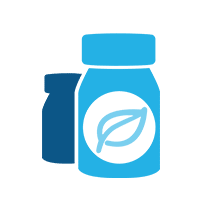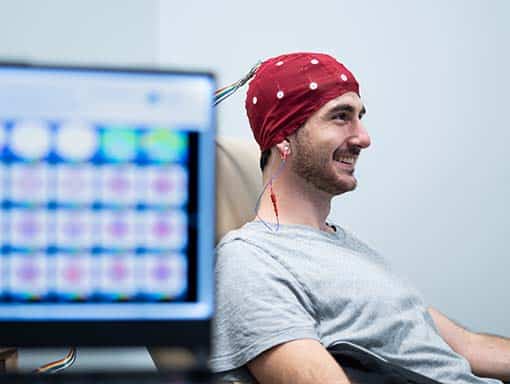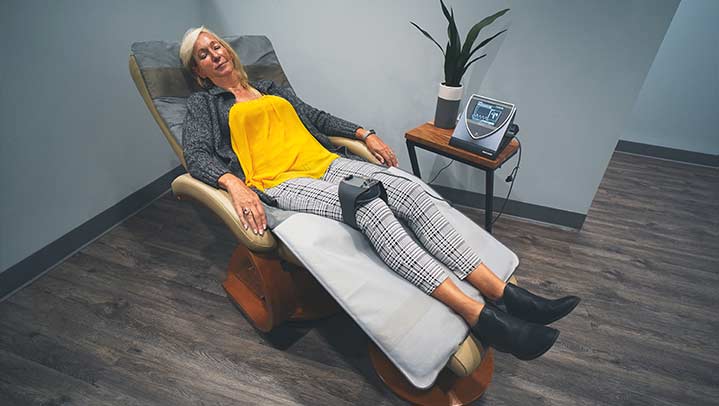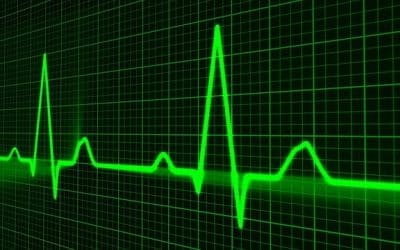Inflammatory Bowel Disease (IBD)
Inflammatory Bowel Disease (IBD) is characterized by chronic inflammation of the gastrointestinal (GI) tract. Crohn’s disease and ulcerative colitis are the two most prevalent IBD conditions, and both are likely caused by a mix of genetic and environmental factors that result in issues with the immune response (1). IBD patients have consistently displayed higher levels of proinflammatory cytokines (2) as well as nitric oxide, both of which can lead to tissue damage (3).
Extivita Therapies for IBD:
Extivita Therapies IBD Recovery:

Hyperbaric Oxygen Therapy

Neurofeedback

Supplements

Nutritional IV Therapy

Pulsed Electromagnetic Field Therapy
Listen to Bryce’s experience with Hyperbaric Oxygen Therapy to treat Ulcerative Colitis
Hyperbaric Oxygen Therapy for Inflammatory Bowel Disease:

See the page on Crohn’s Disease and the page on Ulcerative Colitis for more information.
Effects of HBOT on Inflammatory Bowel Disease:

Decreased Inflammation

Increased Stem Cell Activity

New Blood Vessel Formation
Hyperbaric oxygen therapy stimulates the formation of new blood vessels, healing injured tissues that were unable to get nutrients and oxygen.

Neurofeedback for Inflammatory Bowel Disease:
There is scientific evidence showing the intimate connection between the gut and the brain, and the effect of this shared interaction on gut and psychological well-being. Patients with IBD may benefit from integration of mind and body interventions which may help decrease triggers such as stress and anxiety (6). Neurofeedback is a type of biofeedback which may be helpful in treating symptoms of IBD by calming the nervous system.
IV Therapy for Inflammatory Bowel Disease:
Patients with IBD are at risk for nutrient deficiencies because of reduced dietary intake, inflammation, and the underlying malabsorption (7). Antioxidant depletion can result from dealing with oxidative stress from inflammation occurring in IBD (9). Myers’ cocktail is a form of nutrient therapy which contains vitamin C, magnesium, B12, B6, B5, B complex, and calcium given intravenously (through the veins) (8) . This process bypasses the digestive system and a much higher level of nutrients and antioxidants is directly delivered to your cells. Myers’ cocktail and glutathione are safe and effective adjunctive treatments for IBD.


Pulsed Electromagnetic Field Therapy for IBD:
According to studies, the microcirculation and inside lining of the blood vessels play a critical role in body’s immune balance. In IBD, micro vessels in chronically inflamed and can result in decreased oxygen and nutrient delivery to tissues. In addition, micro vessels are also found to have reduced vessel diameter, vascular density, and diminished blood flow (10, 11). When used in conjunction with HBOT, PEMF therapy may lead to improved microvascular function, blood flow, and therefore tissue and organ health.
News & Research for Inflammatory Bowel Disease:
Effect of pulsed electromagnetic field treatment on programmed resolution of inflammation pathway markers in human cells in culture
Abstract Inflammation is a complex process involving distinct but overlapping biochemical and molecular events that are highly regulated. Pulsed electromagnetic field (PEMF) therapy is increasingly used to treat pain and edema associated with inflammation following...
Role of immunosuppressives in special situations: perianal disease and postoperative period.
Complex perianal disease is associated with poor outcome and requires early effective therapy. Corticosteroids are not effective in perianal fistulising Crohn’s disease, and antibiotics, immunosuppressants and anti-TNF therapy are required. It is important to consider combined medical surgical therapy after accurate imaging using an MRI scan of the pelvis. Drainage of any abscess at examination under anaesthesia and seton insertion are important before introduction of immunosuppressants and anti-TNF therapy. Long-term follow up of patients in a single centre reported responders to azathioprine having a reduced risk of perianal surgery (OR = 0.36; 95% CI: 0.27-0.46), but complex perianal fistulising Crohn’s disease generally requires combination therapy with anti-TNF and azathioprine.
Systematic review: The safety and efficacy of hyperbaric oxygen therapy for inflammatory bowel disease.
Hyperbaric oxygen therapy (HBOT) provides 100% oxygen under pressure, which increases tissue oxygen levels, relieves hypoxia and alters inflammatory pathways. Although there is experience using HBOT in Crohn’s disease and ulcerative colitis, the safety and overall efficacy of HBOT in inflammatory bowel disease (IBD) is unknown. To quantify the safety and efficacy of HBOT for Crohn’s disease (CD) and ulcerative colitis (UC). The rate of adverse events with HBOT for IBD was compared to the expected rate of adverse events with HBOT. MEDLINE, EMBASE, Cochrane Collaboration and Web of Knowledge were systematically searched using the PRISMA standards for systematic reviews. Seventeen studies involving 613 patients (286 CD, 327 UC) were included.
References
- Mattos, Bruno Rafael Ramos de, Maellin Pereira Gracindo Garcia, Julia Bier Nogueira, Lisiery Negrini Paiatto, Cassia Galdino Albuquerque, Caique Lopes Souza, Luís Gustavo Romani Fernandes, Wirla Maria da Silva Cunha Tamashiro, and Patricia Ucelli Simioni. “Inflammatory Bowel Disease: An Overview of Immune Mechanisms and Biological Treatments.” Mediators of Inflammation 2015 (2015). https://doi.org/10.1155/2015/493012.
- Papadakis, K. A., and S. R. Targan. “The Role of Chemokines and Chemokine Receptors in Mucosal Inflammation.” Inflammatory Bowel Diseases 6, no. 4 (November 2000): 303–13. https://doi.org/10.1002/ibd.3780060408.
- Rachmilewitz, D., J. S. Stamler, D. Bachwich, F. Karmeli, Z. Ackerman, and D. K. Podolsky. “Enhanced Colonic Nitric Oxide Generation and Nitric Oxide Synthase Activity in Ulcerative Colitis and Crohn’s Disease.” Gut 36, no. 5 (May 1995): 718–23. https://doi.org/10.1136/gut.36.5.718.
- Akin, M. L., B. M. Gulluoglu, H. Uluutku, C. Erenoglu, E. Elbuken, S. Yildirim, and T. Celenk. “Hyperbaric Oxygen Improves Healing in Experimental Rat Colitis.” Undersea & Hyperbaric Medicine: Journal of the Undersea and Hyperbaric Medical Society, Inc 29, no. 4 (2002): 279–85. https://www.ncbi.nlm.nih.gov/pubmed/12797669
- Granowitz, E. V., E. J. Skulsky, R. M. Benson, J. Wright, J. L. Garb, E. R. Cohen, E. C. Smithline, and R. B. Brown. “Exposure to Increased Pressure or Hyperbaric Oxygen Suppresses Interferon-Gamma Secretion in Whole Blood Cultures of Healthy Humans.” Undersea & Hyperbaric Medicine: Journal of the Undersea and Hyperbaric Medical Society, Inc 29, no. 3 (2002): 216–25. https://www.ncbi.nlm.nih.gov/pubmed/12670123
- Yeh, Ann Ming et al. “Mind-Body Interventions for Pediatric Inflammatory Bowel Disease.” Children (Basel, Switzerland) vol. 4,4 22. 3 Apr. 2017, doi:10.3390/children4040022
- Waśko-Czopnik, Dorota, and Leszek Paradowski. “The influence of deficiencies of essential trace elements and vitamins on the course of Crohn’s disease.” Advances in clinical and experimental medicine : official organ Wroclaw Medical University vol. 21,1 (2012): 5-11.
- Gaby, Alan R. “Intravenous nutrient therapy: the “Myers’ cocktail“. Alternative medicine review: a journal of clinical therapeutic 7 5 (2002): 389-403.
- Yan, Haiyan et al. “Ascorbic acid ameliorates oxidative stress and inflammation in dextran sulfate sodium-induced ulcerative colitis in mice.” International journal of clinical and experimental medicine vol. 8,11 20245-53. 15 Nov. 2015
- Deban, Livija et al. “Multiple pathogenic roles of microvasculature in inflammatory bowel disease: a Jack of all trades” The American journal of pathology vol. 172,6 (2008): 1457-66. doi:10.2353/ajpath.2008.070593
- Hatoum, Ossama A et al. “The vascular contribution in the pathogenesis of inflammatory bowel disease.” American journal of physiology. Heart and circulatory physiology vol. 285,5 (2003): H1791-6. doi:10.1152/ajpheart.00552.2003


